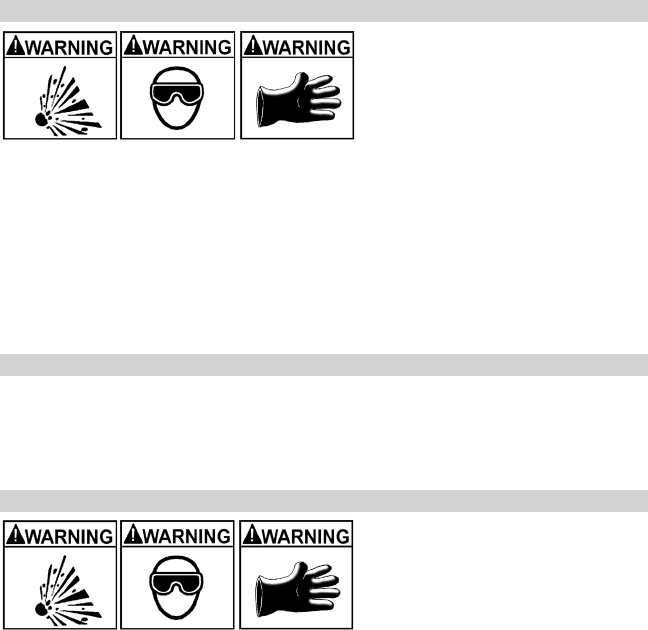
• 37 •
Add distilled water to each cell until the battery acid reaches the level specied 3.4
by the battery manufacturer. Do not overll. For a battery without removable
cell caps, such as valve regulated lead acid batteries (VRLA), carefully follow
the manufacturer’s recharging instructions.
Read, understand and follow all instructions for the charger, battery, vehicle 3.5
and any equipment used near the battery and charger. Study all of the battery
manufacturer’s specic precautions while charging and recommended rates of
charge.
Determine the voltage of the battery by referring to the vehicle owner’s manual 3.6
and make sure that the output voltage selector switch is set to the correct
voltage. If the charger has an adjustable charge rate, charge the battery in the
lowest rate rst.
Make sure that the charger cable clips make tight connections.3.7
CHARGER LOCATION4.
RISK OF EXPLOSION AND
CONTACT WITH BATTERY ACID.
Locate the charger as far away from the battery as the DC cables permit.4.1
Never place the charger directly above the battery being charged; gases from 4.2
the battery will corrode and damage the charger.
Do not set the battery on top of the charger.4.3
Never allow battery acid to drip onto the charger when reading the electrolyte 4.4
specic gravity or lling the battery.
Do not operate the charger in a closed-in area or restrict the ventilation in any 4.5
way.
DC CONNECTION PRECAUTIONS5.
Connect and disconnect the DC output clips only after setting all of the charger 5.1
switches to the “off” position (if applicable) and removing the AC plug from the
electrical outlet. Never allow the clips to touch each other.
Attach the clips to the battery and chassis, as indicated in sections 6 and 7.5.2
FOLLOW THESE STEPS WHEN BATTERY IS INSTALLED IN VEHICLE6.
A SPARK NEAR THE BATTERY
MAY CAUSE A BATTERY
EXPLOSION. TO REDUCE THE
RISK OF A SPARK NEAR THE
BATTERY:
Position the AC and DC cables to reduce the risk of damage by the hood, door 6.1
and moving or hot engine parts. NOTE: If it is necessary to close the hood
during the charging process, ensure that the hood does not touch the metal
part of the battery clips or cut the insulation of the cables.
Stay clear of fan blades, belts, pulleys and other parts that can cause injury.6.2
Check the polarity of the battery posts. The POSITIVE (POS, P, +) battery post 6.3
usually has a larger diameter then the NEGATIVE (NEG, N, -) post.


















